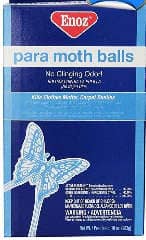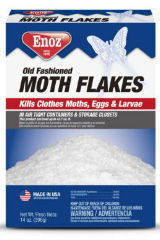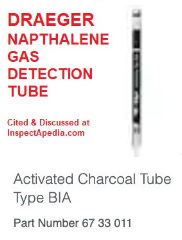 Mothball Odor Test Procedures
Mothball Odor Test Procedures
Tests for off-gassing or odors of mothballs: naphthalene or p-dichlorobenzene
- POST a QUESTION or COMMENT about mothball chemicals, hazards, odors, & odor removal
Mothball or naphthalene odor or gas test procedures & devices.
This article series explains the detection of and risks of exposure to mothball chemicals & odors when moth repellent products are applied indoors in buildings.
We note the possible health hazards from exposure to mothball odors (and gases) as well as the child hazard of eating mothballs or moth repellent products. We discuss methods to reduce mothball chemical & gas exposure.
Page top photo, courtesy of Wikipedia commons, shows a cluster mothballs, or a solid form of naphthalene.
InspectAPedia tolerates no conflicts of interest. We have no relationship with advertisers, products, or services discussed at this website.
- Daniel Friedman, Publisher/Editor/Author - See WHO ARE WE?
Test for Naphthalene, Moth Flakes, Mothball Offgassing Level

Here we list various types of tests that can be used to detect mothball or moth flakes odors & offgassing, including research on the effectiveness or use of these tests.
Tests for Detection of Naphthalene or p-dichlorobenzene in air or to distinguish between the two substances
- Ambre, John, Tsuen Ih Ruo, and Rebecca Smith-Coggins. "Mothball composition: three simple tests for distinguishing paradichlorobenzene from naphthalene." Annals of emergency medicine 15, no. 6 (1986): 724-726.
Abstract: We describe three analytical procedures that can be used to distinguish naphthalene from the less toxic mothball component paradichlorobenzene. An initial presumptive identification can be made by noting the characteristic aroma of the two substances.
This can be followed by one of the three analytical tests, each of which is simple to perform, gives an answer in seconds to minutes, and is definitive enough to eliminate the need for costly additional testing at an analytical reference laboratory.
These tests have as additional advantages that the endpoints are dramatic and the reagents are commonly available.
Excerpt: Place a few crystals of the mothball product in a glass tube or other small container: Add a few drops of chloroform (spectrograde) and a small amount of aluminum chloride anhydrous powder. Naphthalene produces an intense blue color immediately. Paradichlorobenzene produces no reaction. - Cennamo, Nunzio, Luigi Zeni, Ezio Ricca, Rachele Isticato, Vincenzo Manuel Marzullo, Alessandro Capo, Maria Staiano, Sabato D’Auria, and Antonio Varriale. "Detection of naphthalene in sea-water by a label-free plasmonic optical fiber biosensor." Talanta 194 (2019): 289-297.
Excerpt:
At present, capillary gas chromatography [8], gas chromatography-mass spectrometry ... and high-performance liquid chromatography ... are the main methods used for the determination of naphthalene.
- Draeger and Sensidyne produce colorimetric gas detection tubes that, used with calibrated testing pumps, can test for naphthalene in air - Ed.
Draeger: Naphthalene detection tubes, crude or refined naphthalene, using activated charcoal, 3 different tube types, Order No. 6733011, 6728831, 6728631
Sensidyne: NAPHTHALENE 10-100 PPM GAS DETECTOR TUBE [PDF] Tube Number: 153U, Range: 10-100 ppm Naphthalene Colorimetric Gas Detector Tubes For Detection Of Airborne Gases And Vapors - https://www.sensidyne.com/colorimetric-gas-detector-tubes/detector-tubes/153u-naphthalene.php - using isobutyl acetate
See details at GAS DETECTION INSTRUMENTS - Girschikofsky, Maiko, Manuel Rosenberger, Stefan Belle, Malte Brutschy, Siegfried R. Waldvogel, and Ralf Hellmann. HIGHLY SENSITIVE DETECTION OF NAPHTHALENE IN SOLVENT VAPOR USING A FUNCTIONALIZED PBG REFRACTIVE INDEX SENSOR [PDF] Sensors 12, no. 2 (2012): 2018-2025.
Abstract:
We report an optical refractive index sensor system based on a planar Bragg grating which is functionalized by substituted γ-cyclodextrin to determine low concentrations of naphthalene in solvent vapor.
The sensor system exhibits a quasi-instantaneous shift of the Bragg wavelength and is therefore capable for online detection. The overall shift of the Bragg wavelength reveals a linear relationship to the analyte concentration with a gradient of 12.5 ± 1.5 pm/ppm.
Due to the spectral resolution and repeatability of the interrogation system, this corresponds to acquisition steps of 80 ppb. Taking into account the experimentally detected signal noise a minimum detection limit of 0.48 ± 0.05 ppm is deduced. - Menezes, Helvécio C., Breno P. Paulo, Nathália T. Costa, and Zenilda L. Cardeal. NEW METHOD TO DETERMINATION OF NAPHTHALENE IN AMBIENT AIR USING COLD FIBER-SOLID PHASE MICROEXTRACTION AND GAS CHROMATOGRAPHY–MASS SPECTROMETRY [PDF] Microchemical Journal 109 (2013): 93-97.
Abstract:
Naphthalene, a highly volatile polycyclic aromatic hydrocarbon (PAH), is classified as possibly carcinogenic to humans and can be found in various environments.
This paper describes a cold fiber (CF) solid phase microextraction (SPME) sampling method coupled with gas chromatography/mass spectrometry (GC/MS) for determining naphthalene in ambient air.
The method uses a 100 μm polydimethylsiloxane (PDMS) fiber to generate gaseous standards using a permeation tube. The method shows good results for many validation parameters.
The intra-assay precision shows a relative standard deviation (RSD) ranging from 1.04 to 8.11%; the limit of detection (LOD) is 0.33 ± 0.01 μg/m3, and the quantification limit (LOQ) is 0.55 ± 0.01 μg/m3. The method was applied to the determination of naphthalene from real samples collected from indoor and outdoor air.
The results have shown the ability of the method to measure trace levels of naphthalene in the air in different environments.
Conclusion:
This study showed the development of an alternative method for the analysis of naphthalene in ambient air by passive sampling with cooled fiber solid phase microextraction (CF-SPME).
The method is simple, fast, and inexpensive. SPME dispensing pumps ensure portability for sampling and pre-concentration.
The use of a pattern generation system for gas permeation produced the most appropriate conditions for reproducibility in the atmosphere. This procedure was validated and showed good precision, linearity and sensitivity for the range of environmental interest.
The results obtained from the analysis of air samples collected in external and internal envi- ronments have demonstrated the ability of the method to measure trace levels of naphthalene in the air in different environments - [4] McGinley, Charles M., P.E., Michael A. McGinley, MHS, Donna L. McGinley, " “Odor Basics”,
Understanding and Using Odor Testing", paper presentation, The 22nd Annual Hawaii Water Environment Association Conference.,
Honolulu, Hawaii: 6-7 June 2000, St. Croix Sensory Inc. / McGinley Associates, P.A. 13701 - 30th Street Circle North Stillwater, MN 55082 U.S.A. 800-879-9231 stcroix@fivesenses.com, retrieved 9/22/12, original source http://www.fivesenses.com/Documents/Library/33%20 %20Odor%20Basics.pdf, [copy on file as Odor_Basics.pdf] - [5] Ruth, Jon H. "Odor Thresholds and Irritation Levels of Several Chemical Substances: A Review", American Industrial Hygiene Association Journal Volume 47, Issue 3, 1986, retrieved 9/22/12,
- OSHA: DETECTION of NAPTHALENE [PDF]
- [5] Ruth, John R., "Odor Thresholds and Irritation Levels of Several Chemical Substances: A Review", American Industrial Hygiene Association Journal
Volume 47, Issue 3, 1986, retrieved 9/22/12,
Abstract: A collation of odor threshold data for approximately 450 chemical substances is presented. The range of odor thresholds reported in the literature is shown along with any reported threshold of irritation to humans.
These data can assist the industrial hygienist in determining when an “odor” may be in excess of the Threshold Limit Value®, when an organic vapor respirator is not acceptable due to the lack of an odor warning at the end of a cartridge life, and where odors may not indicate a hazard due to extremely low odor thresholds which may be well below the respective TLVs. - OSHA NAPHTHALENE DETECTION PROCEDURE [PDF] U.S. OSHA, - retrieved 2022/08/24, original source: osha.gov/sites/default/files/methods/osha35.pdf
- Zhou, Chun, Qiong-E. Wang, Shan-Shan Gao, and Hui-Sheng Zhuang. DETERMINATION OF NAPHTHALENE BY COMPETITIVE FLUORESCENCE IMMUNOASSAY [PDF] Environmental monitoring and assessment 154, no. 1 (2009): 233-239.
Abstract:
A reliable and sensitive competitive fluorescence immunoassay for the quantitative determination of naphthalene (NA) was developed. 2-naphthoxy acetic acid (NAA) was selected as the hapten of naphthalene.
Active ester method (AEM) was used to couple the NAA to carrier proteins (bovine serum albumin) to form artificial immune antigen.
Male New Zealand white rabbits were immunized with this antigen to obtain polyclonal antibodies, with which, a novel fluorescence immunoassay for detection of NA was described.
Under best conditions, NA can be determined in the concentration range of 0.1–100 µg/L with a detection limit of 0.05 μg/L. The cross-reactivities of the anti-NA antibody to seven structurally related compounds were below 15%.
Some environmental samples were analyzed with satisfactory results. It shows a good accuracy and suitability to analyze NA in environmental water.
Question: movers applied mothballs to furniture in storage: now it stinks and is a health hazard
 We moved and had furniture in storage. The movers applied mothballs to the furniture and now it stinks and has a health risk.
We moved and had furniture in storage. The movers applied mothballs to the furniture and now it stinks and has a health risk.
Are you aware of any test kits or labs that would allow us to test if any residual mothball vapors or pesticide are on the furniture? Thanks
Our moving company applied enoz moth crystals to our rugs and couches. I believe this is paradebentiol (spelling?) rather then naphthalene.
The goods sat in storage and then in our home for a few days. I understand the fume risk will dissipate.
I want a way to test if there is any residue left on the fabric after the smell goes away. Do any tests exist for that? Thank you
- Anonymous by private email 2022/08/23
Moderator reply: various methods to test for naphthalene or similar gases, but probably not cost-justified
Enoz is a U.S. manufacturer of moth flakes, a product that can be safe and effective when used as directed. The company contact information is given below.
Watch out: My OPINION is that moth flakes, because of their much-greater surface area per ounce of material than mothballs, can be quite strong in effect depending on the quantity applied onto a surface or in an area. For that reason, one needs to follow the company's instructions that state:
The moth flakes in this container can treat up to 43.7 cubic feet. Liberally sprinkle moth flakes on the bottom of storage space or container, between folds and layers of articles and an extra amount on top before closing container. See product label for additional information.
Mothballs, moth flakes, crystals and bars are insecticides. They come in a solid form that slowly gives off a vapor that kills moths, moth eggs and their larvae. They are meant to be used in closed, airtight containers so that the vapors they produce are trapped.
Always follow label instructions and take steps to avoid exposure. If any exposures occur, be sure to follow the First Aid instructions on the product label carefully.
I'm not aware of any mothball odor "test kits" but there is a wide range of equipment including gas detection tubes and pumps or other devices that can check for naphtha, the prime constituent of mothballs and that you smell. Please help me to understand what problem we're solving here.If you smell mothballs - which is pretty unambiguous - then you know that naphtha is present at an irritating level.
Detectors used for identification and quantification of naphthalene and methylnaphthalenes include the flame ionization detector (FID), photoionization detector (PID), ultraviolet detection (UV), Fourier transform infrared detection (FTIR), and fluorescence detection (FD). Mass spectrometry is used for confirmation.
The offgassing of moth flakes or mothball odors can take quite some time to dissipate depending on the chemistry of the absorbing materials.
This web page now contains - as a result of your question - among its reference citations, research on testing procedures. I use a simple gas tube sensor from Draeger.
I'm unclear on the need for testing. Why wouldn't smelling be enough? It's true that lower levels of offgassing may continue after the point that you don't smell the odor, but what question are we answering by testing? At what cost?
OTOH if the materials are not successfully offgassing you'll know it as they'll still smell, especially when kept in a small, enclosed space without fresh air ventilation. That might be a useful test.
The distinction between naphthalene and paradichlorobenzene is given by Winkler (1985), cited
at DIFFERENCE BETWEEN PARADICHLOROBENZENE & NAPHTHALENE MOTHBALLS in the page above.
- Contact: Enoz's manufacturer, Willert, USA
4044 Park Avenue
St. Louis, Missouri 63110
United States of America Tel: (+1) 800-325-9680 Email: whp@willert.com Web: https://enozhome.com/product/old-fashioned-moth-flakes/
Willert-China: Willert Home Products Sales (Shanghai) Co., Ltd. Room 2603-2606, Lane 166 Minhong Road Zhonggeng Global Creative Center Minhang District Shanghai 201100 China T: (086) 21 5416 2786 - ENOZ OLD FASHIONED MOTH BALLS SAFETY DATA SHEET [PDF] (2015) - source: home depot.
- ENOZ PRODUCT LIST & MATERIAL SAFETY DATA SHEET [PDF] (2011)
Excerpt: All products contain p-dichlorobenzene as the active ingredient. [ p-dichlorobenzene (1,4-dichlorobenzene) ]
Excerpt: White balls, blocks, crystals, nuggets or tablets. Some products may be encased in paper bags (packets) or plastic containers and some products contain fragrance. Harmful if swallowed or inhaled. Dust and vapors may cause eye and respiratory tract irritation. Flammable.
...
Reader Comments, Questions & Answers About The Article Above
Below you will find questions and answers previously posted on this page at its page bottom reader comment box.
Reader Q&A - also see RECOMMENDED ARTICLES & FAQs
On 2021-01-10 - by (mod) - trouble getting mothball smell out of carpet
Jake,
If the carpet is valuable, you might try having it temporarily removed for professional cleaning and you might replace the padding below.
You should also be sure to do a smell patch test as we described in this article series so that you're confident that the carpet or its padding are the actual odor source and not other building surfaces or contents.
On 2021-01-09 by Jake
I can’t get mothball smell out of carpet. I think the odor is trapped under the pad. I’ve tried ventilation, heat, vacuums and steam cleaning.
The smell always returns.
Should I have the carpet replaced? The sunlight can’t reach that part of carpet.
...
Continue reading at SMELL PATCH TEST to FIND ODOR SOURCE or select a topic from the closely-related articles below, or see the complete ARTICLE INDEX.
Or see these
Recommended Articles
- GAS DETECTION INSTRUMENTS
- MOTHS, MOTHBALL ODORS - home
- HEALTH EFFECTS of EXPOSURE to MOTHBALLS
- REDUCE INDOOR EXPOSURE to MOTHBALL CHEMICALS
- GET RID of MOTHBALL ODORS
- LIFE EXPECTANCY of MOTHBALLS
- MOTHBALL ODOR IMPACT on REAL ESTATE SALES
- TERMITES & NAPTHALENE HAZARDS
- NAPTHALENE POISONING SYMPTOMS
- NAPTHALENE HEALTH HAZARD RESEARCH
- NAPTHALENE / PARABENTIOL OFF-GAS TESTING
- RESEARCH on NAPTHALENE HEALTH HAZARDS
- ODORS GASES SMELLS, DIAGNOSIS & CURE - home
- PESTICIDE EXPOSURE HAZARDS
- SMELL PATCH TEST to FIND ODOR SOURCE
- TERMITES & NAPTHALENE HAZARDS
Suggested citation for this web page
NAPTHALENE / PARABENTIOL OFF-GAS TESTING at InspectApedia.com - online encyclopedia of building & environmental inspection, testing, diagnosis, repair, & problem prevention advice.
Or see this
INDEX to RELATED ARTICLES: ARTICLE INDEX to BUILDING ODOR DIAGNOSIS & CURE
Or use the SEARCH BOX found below to Ask a Question or Search InspectApedia
Or see
INDEX to RELATED ARTICLES: ARTICLE INDEX to INSECT DAMAGE
Or use the SEARCH BOX found below to Ask a Question or Search InspectApedia
Ask a Question or Search InspectApedia
Try the search box just below, or if you prefer, post a question or comment in the Comments box below and we will respond promptly.
Search the InspectApedia website
Note: appearance of your Comment below may be delayed: if your comment contains an image, photograph, web link, or text that looks to the software as if it might be a web link, your posting will appear after it has been approved by a moderator. Apologies for the delay.
Only one image can be added per comment but you can post as many comments, and therefore images, as you like.
You will not receive a notification when a response to your question has been posted.
Please bookmark this page to make it easy for you to check back for our response.
IF above you see "Comment Form is loading comments..." then COMMENT BOX - countable.ca / bawkbox.com IS NOT WORKING.
In any case you are welcome to send an email directly to us at InspectApedia.com at editor@inspectApedia.com
We'll reply to you directly. Please help us help you by noting, in your email, the URL of the InspectApedia page where you wanted to comment.
Citations & References
In addition to any citations in the article above, a full list is available on request.
- In addition to citations & references found in this article, see the research citations given at the end of the related articles found at our suggested
CONTINUE READING or RECOMMENDED ARTICLES.
- Carson, Dunlop & Associates Ltd., 120 Carlton Street Suite 407, Toronto ON M5A 4K2. Tel: (416) 964-9415 1-800-268-7070 Email: info@carsondunlop.com. Alan Carson is a past president of ASHI, the American Society of Home Inspectors.
Thanks to Alan Carson and Bob Dunlop, for permission for InspectAPedia to use text excerpts from The HOME REFERENCE BOOK - the Encyclopedia of Homes and to use illustrations from The ILLUSTRATED HOME .
Carson Dunlop Associates provides extensive home inspection education and report writing material. In gratitude we provide links to tsome Carson Dunlop Associates products and services.


